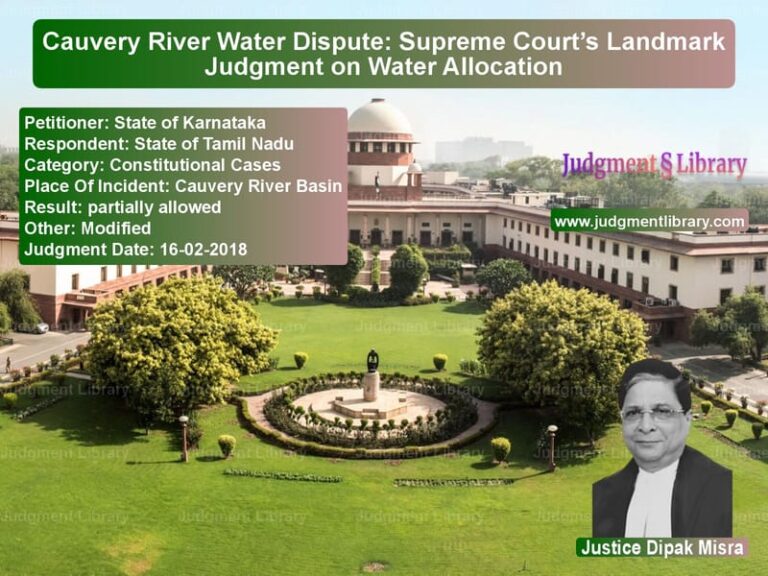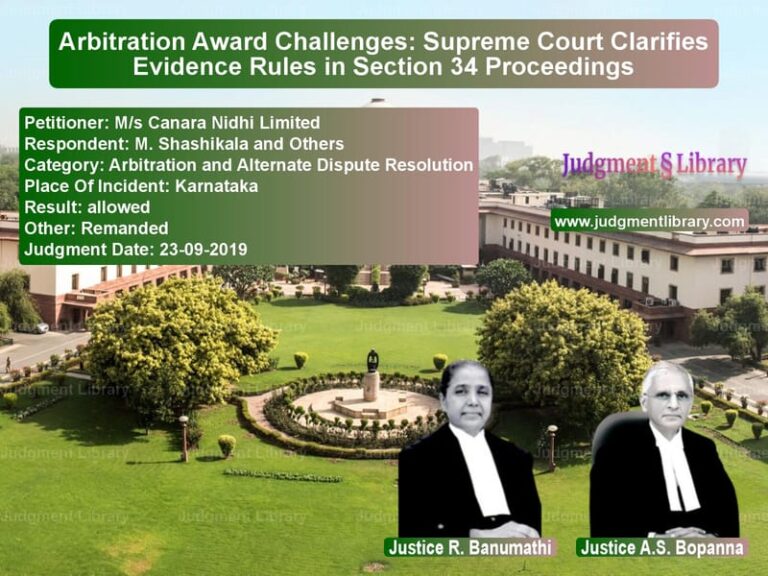Land Compensation Revised: Supreme Court Fixes Market Value for Panchkula Acquisition
The Supreme Court of India, in the case of Ashok Kumar & Another vs. State of Haryana, addressed the issue of fair compensation for land acquired by the state for residential and commercial development in Panchkula, Sector-21. The case revolved around determining the correct market value of the acquired land, ensuring that landowners received just compensation in accordance with legal precedents and statutory provisions.
The Court ruled that compensation should not be restricted to the claim made by the landowner but should reflect the true market value of the land. The judgment provided clarity on the methodology for calculating compensation and reaffirmed the principle that courts have a duty to award just and fair compensation, irrespective of the original claims filed by the landowners.
Background of the Case
The dispute arose from the acquisition of 46.93 acres of land in Village Fatehpur, Haryana, by the State of Haryana under the Land Acquisition Act, 1894. The notification under Section 4 of the Act was issued on September 19, 1983, for the development of residential and commercial properties in Panchkula, Sector-21.
The key issue in the case was whether the landowners should receive compensation at the rate of Rs. 250 per square yard, as awarded in similar cases in nearby villages such as Judian and Devi Nagar, or a lower rate due to differences in location and accessibility.
Arguments Presented
Petitioner’s (Ashok Kumar & Another) Arguments
- The land in Village Fatehpur was acquired for the same purpose as land in nearby villages, where the Supreme Court had awarded compensation of Rs. 250 per square yard.
- The acquired land had access to roads and infrastructure, making it suitable for development and justifying a higher compensation rate.
- Precedents established in similar land acquisition cases should be applied to ensure uniformity in compensation.
- The principle of just and fair compensation should override any limitations on claims made by individual landowners.
Respondent’s (State of Haryana) Arguments
- The landowners had only claimed Rs. 125 per square yard, so the Court should not award more than what was initially claimed.
- The acquired land did not have the same advantages as properties in adjoining villages where Rs. 250 per square yard was granted.
- The land in Fatehpur was located approximately 375 yards away from the national highway and had only a narrow road for access, unlike land in Devi Nagar, which had extensive highway frontage.
- The principles of market value assessment should consider location and accessibility differences before fixing compensation.
Supreme Court’s Ruling
The Supreme Court, in a judgment delivered by Justices Kurian Joseph and Rohinton Fali Nariman, ruled in favor of revising the compensation rate but stopped short of granting the full Rs. 250 per square yard sought by the petitioners. The key observations and rulings of the Court were as follows:
1. Compensation Should Not Be Restricted to the Claimed Amount
The Court emphasized that under the Land Acquisition Act, 1894, courts are not bound by the amount claimed by landowners when awarding compensation. The Court cited Section 25 of the Act, stating:
“It is the duty of the Court to award just and fair compensation taking into consideration the true market value and other relevant factors, irrespective of the claim made by the owner.”
The Court referred to previous rulings, including:
- Bhag Singh vs. Union Territory of Chandigarh (1985) – Holding that the government must pay landowners the true market value of the acquired land, regardless of the amount initially claimed.
- Bhimasha vs. Special Land Acquisition Officer (2008) – Establishing that courts should not limit compensation to the amount stated in the pleadings.
2. Market Value Must Be Determined Based on Comparable Cases
The Court analyzed previous cases involving land acquisition for the same purpose in nearby villages:
- Village Judian: Compensation was fixed at Rs. 250 per square yard in a case where land had access to a state highway.
- Village Devi Nagar: Land acquired in 1987, with extensive national highway frontage, was also awarded Rs. 250 per square yard.
However, since Village Fatehpur’s land was located 375 yards away from the national highway, the Court determined that it did not warrant the same valuation as the more favorably located properties.
3. Fair Compensation Fixed at Rs. 200 per Square Yard
Taking into account the proximity to the highway and other location-based factors, the Supreme Court fixed the final compensation rate at Rs. 200 per square yard, reasoning that:
“Having regard to the factual and legal position obtained above, we are of the considered view that the just and fair compensation in the case of appellants would be Rs. 200 per square yard.”
4. Statutory Benefits to Be Provided
The Court ruled that the landowners were entitled to all statutory benefits, including:
- Solatium as per the Land Acquisition Act.
- Interest on delayed payments.
- Other entitlements under applicable laws.
Final Verdict
The Supreme Court’s ruling resulted in the following directives:
- The compensation for land in Village Fatehpur was fixed at Rs. 200 per square yard, balancing the need for fair valuation with location-based considerations.
- The Haryana government was directed to deposit the revised compensation amount within three months before the Executing Court.
- The landowners were granted all statutory benefits applicable under the law.
Conclusion
This ruling reinforces the fundamental principles governing land acquisition compensation:
- Courts have a duty to award just and fair compensation, even if it exceeds the amount originally claimed by landowners.
- Market value assessment must be based on comparable cases, taking location and accessibility into account.
- Landowners should receive full statutory benefits when their land is acquired by the government.
The judgment serves as an important precedent for land acquisition cases, ensuring that landowners receive equitable compensation in line with the true market value of their properties.
Don’t miss out on the full details! Download the complete judgment in PDF format below and gain valuable insights instantly!
Download Judgment: Ashok Kumar & Anothe vs State of Haryana Supreme Court of India Judgment Dated 18-02-2016-1741852786246.pdf
Direct Downlaod Judgment: Direct downlaod this Judgment
See all petitions in Property Disputes
See all petitions in Damages and Compensation
See all petitions in Landlord-Tenant Disputes
See all petitions in Judgment by Kurian Joseph
See all petitions in Judgment by Rohinton Fali Nariman
See all petitions in partially allowed
See all petitions in supreme court of India judgments February 2016
See all petitions in 2016 judgments
See all posts in Civil Cases Category
See all allowed petitions in Civil Cases Category
See all Dismissed petitions in Civil Cases Category
See all partially allowed petitions in Civil Cases Category







